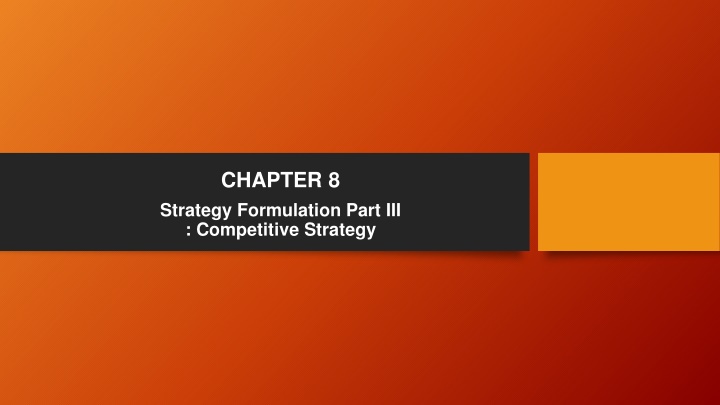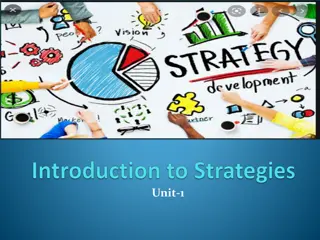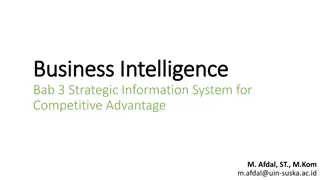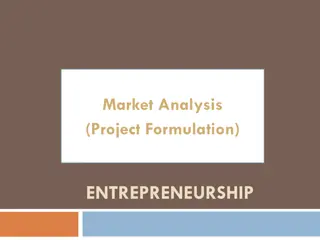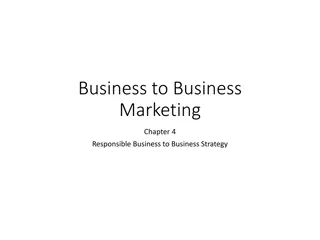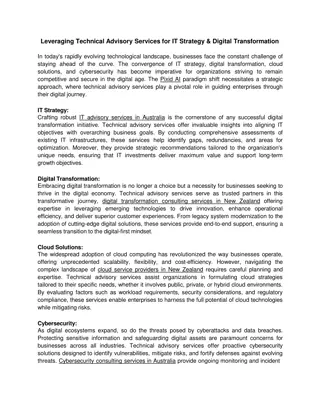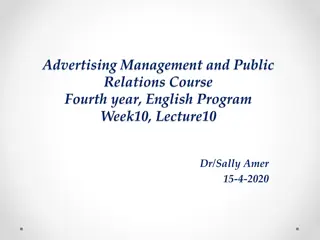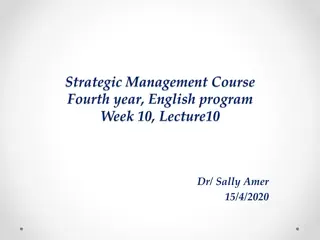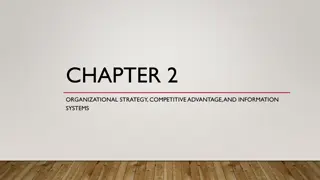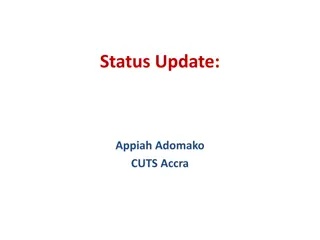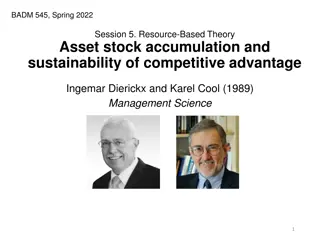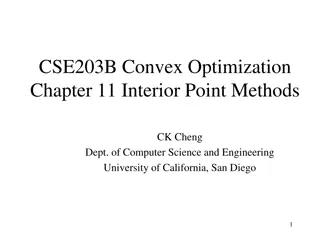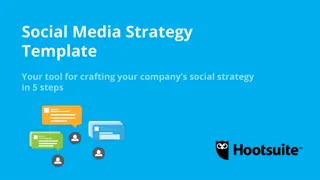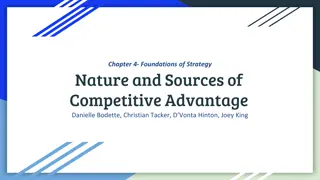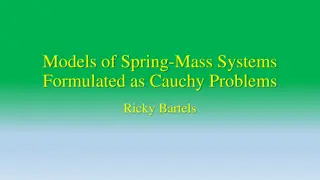Competitive Strategy Formulation: Steps and Tools" (40 characters)
The process of competitive strategy formulation through steps like mission, vision, and objective setting, along with tools like the value proposition and activity map. Dive into Porters' Generic Competitive Strategies and the concept of generic strategies to enhance your understanding and application of competitive strategy within specific industries or market segments.
Download Presentation

Please find below an Image/Link to download the presentation.
The content on the website is provided AS IS for your information and personal use only. It may not be sold, licensed, or shared on other websites without obtaining consent from the author.If you encounter any issues during the download, it is possible that the publisher has removed the file from their server.
You are allowed to download the files provided on this website for personal or commercial use, subject to the condition that they are used lawfully. All files are the property of their respective owners.
The content on the website is provided AS IS for your information and personal use only. It may not be sold, licensed, or shared on other websites without obtaining consent from the author.
E N D
Presentation Transcript
CHAPTER 8 Strategy Formulation Part III : Competitive Strategy
Steps of Strategic Management Process Ch. 4 & 5 Ch. 6, 7, & 8 Ch. 9 & 10 Ch. 11
5-box Strategy 3 Mission Vision Objective What is the goal? External environment analysis Corporate strategy Where will we play Competitive (Business) strategy Unique Value Proposition Activity Map How will we win in chosen markets? Internal environment analysis (Supporting Value Chain Activities) What capabilities must be in place to win? Strategy implementation + Evaluation & control What management systems are required? Lafley & Martin, 2013. Playing to Win.
Competitive Strategy (Business Strategy) Focuses on improving competitive position of company s products or services within the specific industry or market segment Play to WIN ! Be UNIQUE ! NOT play to compete (or participate) NOT try to become the BEST
Competitive Advantage Value Proposition focuses externally on the customer + Strategy is fundamentally integrative, bringing the demand and supply sides together Value Chain focuses internally on operations 5
Porters Generic Competitive Strategy Broad mass market Unique product/service Premiums charged Less price sensitivity brand royalty Increasing entry barrier Low-cost competitive strategy Broad mass market Efficient-scale facilities Cost reductions/minimization lower cost lower price Increasing market share Increasing entry barrier Specific group or geographic market focus Differentiation in target market Special needs of narrow target market Low-cost competitive strategy Focus on market segment Niche focused Cost advantage in market segment
Concept of Generic Strategies 20 20 20 18 18 15 15 16 16 14 14 13 13 14 14 12 12 12 12 Price 10 10 9 9 Costs 8 8 Margin 7 7 5 5 6 6 3 3 4 4 2 2 0 0 Other competitors within the industry Cost Leadership firms Differentiation firms
An Example of Cost Leadership Value Chain Firm Infrastructure Relative few management layers to reduce overhead Simplified planning practices to reduce planning costs Cost effective MIS systems Human Resource Management Effective training programs to improve Worker efficiency and effectiveness Consistent policies to reduce turnover costs Margin Investments in technology in order to reduce costs associated with manufacturing processes Frequent evaluation processes to monitor suppliers performances Technological Development Easy-to-use manufacturing technologies The value chain can that enables cost leadership strategy must align individual value activities in a consistent way. Systems and procedures to find the lowest cost products to Purchase raw materials Highly efficient systems to link suppliers products with the firm s production processes Procurement Effective product installations to reduce frequency and severity of recalls Achieving economies of scale to minimize manufacturing Costs Delivery schedule that reduces costs Small, highly trained sales Force Selection of low cost transport carriers Products priced to generate sales volume Margin Efficient plant scale Cost-centric organizational culture Inbound logistics Operation Outbound logistics Marketing and sales Service
Cost Leadership Strategy is especially powerful when price competition is the key competitive factor when the products are standardized or are commodities that are easily obtainable from different producers when brand differentiation does not appeal to the buyers when switching cost is so low that buyers are flexible enough to change their purchasing sources when a large number of buyers have strong bargaining power over price
Value Chain Analysis to Identify Differentiation Potential Can we say that our product is designed to provide superior quality and special features to the customers so that they are willing to pay premium price? Engineering and design Do our purchasing division managers find a few excellent suppliers who provide required materials for our differentiated products? Do suppliers suggest useful ideas for our differentiated products? Purchasing Assembling and production Is the manufacturing process adequate to produce high quality product? Sales and marketing Are sales and marketing good enough to bring superior customer satisfaction? Are after service activities aligned with the specific brand image that our company wants to pursue? After service
Attractiveness of Differentiation Strategy absorbing shock against the strategy of the existing competitors When buyers have loyalty to brands and models, they are willing to pay higher price raising higher entry barrier by making it difficult for potential entrants to overcome customer loyalty and the uniqueness mitigating the bargaining power of even big buyers competitors products or services are not attractive alternatives withstanding price hike by powerful suppliers due to its ability to charge higher price and to achieve higher margins weakening the threats of substitutes
Integration of competitive strategies choose and pursue multiple generic business level strategies at the same time choose and pursue only one of the generic business level strategies Stuck-in-the-middle Companies successfully integrated multiple strategies -- Not employ both strategies at the same time (apply one strategy to build a firm base then move on to use another strategy) If you want to be something for everybody, you will be nothing to anybody
Value Proposition - Essence of Competitive Strategy Unique value proposition Tailored value chain activities
Value Proposition Value proposition checklist 1 Target customer clearly defined Value proposition 2 Benefits and price explicitly stated A clear statement of product/service benefits and price that can be provided to a target customer group 3 Viable in light of competitor value proposition 4 Achievable with current resources and capabilities Unique and tailored value chain activities 5 Evidence of adequate demand and return
Examples of Value Proposition Company / Product or service McDonald Target customer Benefit Price Mass customer looking for convenience - Service speed - Consistent quality - Clean and friendly environments 20% of the price at fine-dining restaurants Volvo Station Wagon Safety-conscious Durability and safety 20% price premium compared to other American wagon upscale families Affluent men interested in appearance and fashion - Status - Prestige At least, $10,000 Patek Phillippe Watch
Activity Map of IKEA Target Customer: People with thin wallet, People with more time than money Food, childcare promote long visits More impulse buying High-volume production Stores promote heavy traffic and self-service Low price IKEA style Sourcing from long-term suppliers Flat Self- packaging Self- delivery by customers assembly by customers In-house design Cheaper materials Instant gratification Suburban locations, parking Full Modular designs inventory at each store Tailored value chain activities Unique Value Proposition
Activity Map of Edward Jones one of the top four securities (brokerage) company in the U.S Charge: $100 per trade (other low- priced brokers charge $8)
Edward Joness Strategy Statement To grow to 17,000 financial advisers by 2012 by offering trusted and convenient face-to-face financial advice to conservative individual investors who delegate their financial decisions, through a national network of one-financial adviser offices. Collis, D. J. & Rukstad, M. G. 2008. Can you say what your strategy is? Harvard Business Review,
conservative Our investment philosophy is long-term buy and hold. We do not sell penny stocks, commodities, or other high-risk instruments. As a result we do not serve day traders and see no need to offer online trading. We charge commissions on trades because this is the cheapest way to buy stocks (compared with a wrap fee, which charges annually as a percentage of assets) when the average length of time the investor holds the stock or mutual fund is over 10 years. Collis, D. J. & Rukstad, M. G. 2008. Can you say what your strategy is? Harvard Business Review,
Individual We do not advise institutions or companies. We do not segment according to wealth, age, or other demographics. The company will serve all customers that fit its conservative investment philosophy. Brokers will call on any and every potential customer. Stories abound within Jones of millionaires who live in trailers people all the other brokerages would never think of approaching. Collis, D. J. & Rukstad, M. G. 2008. Can you say what your strategy is? Harvard Business Review,
Investors Our basic service is investment. We do not seek to offer services such as checking accounts for their own sake, but only as part of the management of a client s assets. Collis, D. J. & Rukstad, M. G. 2008. Can you say what your strategy is? Harvard Business Review,
who delegate their financial decisions We do not target self-directed do-it-yourselfers, who are comfortable making their own investment decisions. We are also unlikely to serve validators, who are merely looking for reassurance that their decisions are correct. Collis, D. J. & Rukstad, M. G. 2008. Can you say what your strategy is? Harvard Business Review,
Good Strategy is Activity Map UNIQUE Value Proposition Tailored Value Chain
Three questions on Ch. 8 1. Which area represents the strategic sweet spot of a company? (Technology, Industry demographics, regulation, and so on) CUSTOMERS needs COMPETITORS offerings COMPANY S capabilities
Three questions on Ch. 8 2. Do you agree on Michael Porter s claim that a company must choose and pursue only one of the generic strategies? Why or why not? 3. Edward Jones 1) What is Edward Jones competitive strategy? What is the main value proposition? 2) What are the sources of Edward Jones competitive advantage? Do you think it will be easy for competitors to imitate Edward Jones strategy? Why or why not?
[Practice Questions] JetBlue 1. Draw JetBlue s competitive strategy into an activity system map. Place 1~3 items in the center which show the value proposition, and draw out the activities related to the propositions. Draw 5-box strategy of JetBlue 2. As the case described, JetBlue was quite successful in its early stage and came close to the level of Southwest Airline, a legend in the LCC industry. Think about whether JetBlue s competitive advantage will be sustainable. If not, what are possible reasons or factors that may cause trouble for JetBlue s strategy?
For presentation JetBlue 5-box strategy
For presentation 1. JetBlue Activity System Target customer:
For presentation 2. Will JetBlue s competitive advantage be sustainable? If not, what are possible reasons or factors that may cause trouble for JetBlue s strategy?
